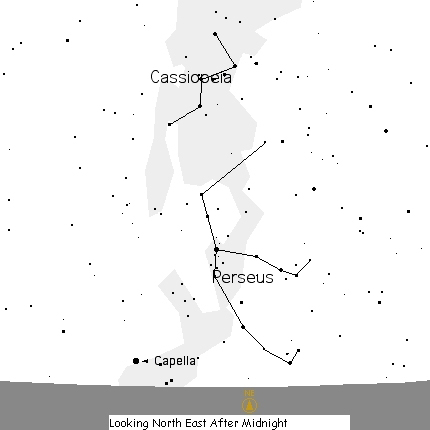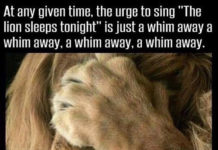
Right now, Earth is being bombarded by particles from space! But don’t worry, it’s just the annual Perseid Meteor Shower, which has returned to our skies. The Perseids, usually the finest meteor shower of the year, rise to a peak gradually over several weeks and then fall off in numbers rapidly after the peak. Perhaps you’ve seen some Perseids already?
The best night for watching meteors will be Tuesday August 11 and into the early morning hours of August 12. Wednesday night of the 12/13 may be good too. By the weekend, the shower will have dwindled to a trickle. Unfortunately, this year the waning Gibbous Moon will rise around 11 pm. The Moon is beautiful, but don’t stare at it! Bright moonlight ruins night vision and it will wipe out any faint Perseids in that part of the sky.
Decent numbers of Perseids can be seen beginning around 10 pm but the show really picks up after midnight and continues until dawn. Meteor showers are best after midnight because the spinning Earth has turned you directly into the oncoming meteor stream. Although meteors can appear from anywhere in the sky, the point (radiant) in space from which these meteors appear to originate lies within the constellation Perseus, which at this time of year rises in the northeast. Perseus can be found below the W-shaped constellation Cassiopeia.
In the evening hours, the “radiant point” is below the horizon. By dawn, Earth has spun you around so that the “radiant point” is nearly overhead and the meteors will rain down from the top of the sky. At the peak, sky watchers can expect to see dozens of fast, bright and colorful meteors per hour. The Perseids are also noted for their long, smoky trails.
A meteor shower occurs when the Earth passes through the trail of debris strewn behind a comet as it orbits the Sun. The Perseid meteors are tiny grain-sized bits of icy, gravelly debris that were shed by Comet Swift-Tuttle in one of its (130 year) orbits around the Sun. All comets release a dusty debris tail and every year at this time, Earth intersects Swift-Tuttle’s orbit and ploughs through its debris stream. The debris will vaporize due to friction with the air, and we’ll see each vaporizing bit as a bright streak in our night sky — meteors!
Sun. All comets release a dusty debris tail and every year at this time, Earth intersects Swift-Tuttle’s orbit and ploughs through its debris stream. The debris will vaporize due to friction with the air, and we’ll see each vaporizing bit as a bright streak in our night sky — meteors!
To best observe the Perseids, find a dark site with an open view of as much sky as possible and give your eyes at least 10 minutes to adjust to the dark. Like bright moonlight, city lights can completely blot out a meteor shower. Use trees and buildings to block them out if you’re not going out to the country. Dress warmly and get comfy in a reclining lawn chair or lay on a blanket on the ground and watch attentively in all parts of the sky. Soon you’ll see “shooting stars” racing along the Milky Way. The warmth of northern summer makes the Perseid Meteor shower one of the year’s most inviting sky shows.
If you’re up before dawn, the brilliant “star” blazing away in the east is our sister planet, Venus. It’s in the constellation of Gemini. And reddish Mars gleams above Venus.
Clear Skies!



